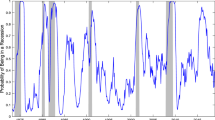Abstract
This paper aims to explain crude oil price volatility and its relationship respect to some macroeconomic and financial variables. Finding the main drivers of oil price dynamics is a crucial element for the definition of adequate monetary policies and risk management purposes. The role of macroeconomic and financial variables is analyzed in a Vector Error Correction Model framework, in order to test the existence of a long run equilibrium in the oil price dynamics. We use monthly data for crude oil prices, the Dollar/Euro exchange rate, the US interest rate, the crude oil Futures open interest, the US oil imports and the gold price over the period 1993–2009. One cointegrating relationship is found which allows to identify a long run equilibrium between the variables.

Similar content being viewed by others
Notes
According to the International Energy Agency (EIA) the OECD countries still represent 60 % of the world energy consumption.
WTI is the benchmark for crude oil spot prices and the underlying commodity of the NYMEX’s oil future contracts (Geman 2005).
The GAUSS code is available at: http://qed.econ.queensu.ca/jae/2003-v18.1/bai-perron/.
In the following, for the VAR(p) model we exclude the presence of exogenous variables.
\(-\Upgamma\) is the matrix of adjustment coefficients which has dimension n × r and the coefficients, γ i , describe the speed of adjustment of the particular series Y t to deviation from the cointegration relationship, i.e., the equilibrium errors.
In an Engle–Granger framework (Engle and Granger 1987) given two price series Y 1,t and Y 2,t , both I(1), the “cointegration regression”, Y 1,t = α + β Y 2,t + z t , is estimated to fit equilibrium relationship. The Ordinary Least Squares (OLS) residuals z t from the cointegrating regression are estimates of the equilibrium errors.
References
Amano RA, Norden S (1998) Exchange rates and oil prices. Rev Int Econ 6(4):683–694
Amano RA, Norden S (1998) Oil prices and the rise and fall of the US real exchange rate. J Int Money Finance 17(2):299–316
Bai J, Perron P (1998) Estimating and testing linear models with multiple structural changes. Econometrica 66(1):47–78
Bai J, Perron P (2003) Computation and analysis of multiple structural change models. J Appl Econ 18(1):1–22
Bencivenga C, Sargenti G, D’Ecclesia RL (2011) Integration of energy commodity markets: the case of Europe and US. J Risk Manag Financ Inst 4:301–313
Chen SS, Chen HC (2007) Oil prices and real exchange rates. Energy Econ 29(3):390–404
Chen Y, Rogoff K, Rossi B (2008) Can exchange rates forecast commodity prices? Working paper, Hardward University
Chevillon G, Rifflart C (2007) Physical market determinants of the price of crude oil and the market premium. ESSEC, Paris
Cuaresma JC, Breitenfellner A (2008) Crude oil and the Euro-Dollar exchange rate: a forecasting exercise. Monet Policy Econ 4:102–121
Diba B, Grossman H (1984) Rational bubbles in the price of gold. National Bureau of Economic Research working paper series, vol w1300
Engle RF, Granger CWJ (1987) Co-integration and error correction: representation, estimation, and testing. Econometrica 55(2):251–276
Geman H (2005) Commodity and commodity derivatives. Wiley Finance, New York
Hamilton JD (2009a) Understanding crude oil prices. Energy J 30(2):179–206
Hamilton JD (2009b) Causes and consequences of the oil shock of 2007-2008. Brookings papers on Economic Activity, Spring, pp 215–259
Johansen S (1988) Statistical analysis of cointegration vectors. J Econ Dyn Control 12:231–254
Johansen S (1994) The role of constant and linear terms in cointegration of nonstationary variables. Econ Rev 13:205–209
Johansen S (1995) Likelihood-based Inference in cointegrated vector autoregressive models. Oxford University Press, Oxford
Johansen S (2005) Interpretation of cointegrating coefficients in the cointegrated vector autoregressive model. Oxford Bull Econ Stat 67(1)
Kaufmann RK, Ullman B (2009) Oil prices, speculation and fundamentals: interpreting causal relationship among spot and futures prices. Energy Econ 31(4):550–558
Krugman P (2008) The oil nonbubble. The New York Times Opinion
Malliaris AG, Malliaris M (2009) Time series and neural networks comparison on gold, oil and the euro. International joint conference on neural networks (IJCNN), 1961–1967
Mu X, Ye H (2011) Understanding the crude oil price: how important is the China factor? Energy J 32(4):69–92
Ng S, Perron P (2001) Lag length selection and the construction of unit root tests with good size and power. Econometrica 69(6):1519–1554
Roubini N (2009) Big crash coming. http://finance.yahoo.com/news
Rubin J (2009) Oil prices caused the current recession. http://www.oil-price.net
Schulmeister S (2000) Globalization without global money: the double role of the dollar as national corrency and as world currency and its consequences. J Post Keneysian Econ 22:365–395
Soros G (2008) Rocketing oil price is a bubble. http://www.telegraph.co.uk/finance
Stevans LK, Sessions DN (2008) Speculation, futures prices and the US real price of crude oil. Economics working paper. Christian-Albrechts-University, Kiel
Stock JH, Watson MW (1988) Testing for common trends. J Am Stat Assoc 83:1097–1107
Wang ML, Wang CP, Huang TY (2010) Relationships among oil price, gold price, exchange rate and international stock market. Int Res J Finance Econ 47:80–89
Author information
Authors and Affiliations
Corresponding author
Rights and permissions
About this article
Cite this article
Bencivenga, C., D’Ecclesia, R.L. & Triulzi, U. Oil prices and the financial crisis. Rev Manag Sci 6, 227–238 (2012). https://doi.org/10.1007/s11846-012-0083-z
Received:
Accepted:
Published:
Issue Date:
DOI: https://doi.org/10.1007/s11846-012-0083-z




